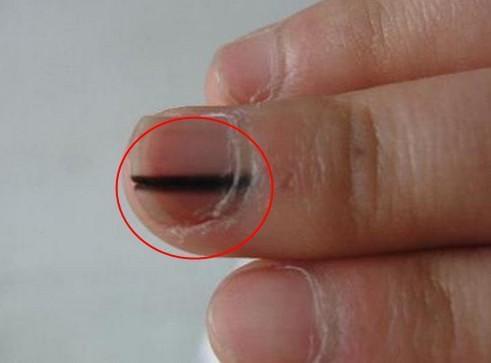
Your hands tell a story. They’re a map of a life well-lived—showing the faint scars from old projects, the weathered skin from years of gardening, and the strong grip that has held so much. We glance at them every day, often without a second thought. But sometimes, a new chapter in that story appears without warning. You might be clipping your nails or simply washing your hands when you see it: a dark, vertical streak, like a splinter of ink, running from the base of your nail to its tip. It doesn’t wash off. It grows with the nail.
It’s a striking and unsettling sight. Your mind might try to explain it away as a bruise from hitting your finger, but if you can’t recall an injury, a more serious question forms. A black nail streak? Your cells are changing… in a way that demands your immediate and serious attention.
Before we let fear take the wheel, it’s crucial to understand what that streak most likely is, and why that “change” in your cells is a signal you cannot afford to ignore.
The Prime Suspect: A Awakening in the Nail Factory
That dark streak has a medical name: longitudinal melanonychia (long-gi-tood-nal mel-an-o-ny-kee-a). Let’s break that down. Your nails are produced in a factory at the base of your nail called the matrix. This factory contains cells called melanocytes, which are responsible for producing the pigment that gives your skin and hair its color.
Normally, these pigment-producing cells in the nail matrix are quiet; they don’t deposit much color into the nail. But sometimes, for a variety of reasons, they can be stimulated to become active. When this happens, they start producing melanin pigment, which gets incorporated into the growing nail, creating that vertical, pigmented streak.
Think of it like a factory assembly line that usually makes clear glass. Suddenly, one part of the factory starts adding black dye to the glass. The result is a dark streak that runs the entire length of the pane as it’s produced.
The Spectrum of “Change”: From Benign to Critical
The “change” in your cells can fall anywhere on a spectrum, which is why a doctor’s evaluation is non-negotiable.
1. The Benign (Harmless) Changes: The vast majority of the time, especially in people with darker skin tones, these streaks are completely benign. The cellular “change” is simply activation, not mutation. Common causes include:
- Trauma: Repeated friction from tight shoes or a single injury to the nail base can wake up the pigment cells.
- Medications: Certain drugs, like some chemotherapy agents or antimalarials, can cause hyperpigmentation as a side effect.
- Normal Pigmentation: For many individuals of African, Asian, or Hispanic descent, multiple streaks are a normal occurrence and no cause for alarm.
2. The Critical Change: Subungual Melanoma
This is the reason a black streak must never be ignored. Sometimes, the “change” in the cells is not just activation, but a malignant transformation. Subungual melanoma is a form of skin cancer that develops in the nail matrix.
In this case, the melanocytes have become cancerous. They multiply uncontrollably and produce excess pigment, which forms the streak. This is the most dangerous form of skin cancer for the hands and feet, and it accounts for a significant portion of melanomas in people of color.
Red Flags: When the “Change” is an Emergency**
This is the information that can save a life. While a single streak may be harmless, certain signs point strongly toward a potential melanoma. Remember the ABCDEF rule for melanoma of the nail:
- Age: Most common in the 5th to 7th decade of life (50s-70s), as well as in people of African, Asian, and Native American descent.
- Brown to black band, with a Border that is irregular or blurred.
- Change in the nail band’s width or color, or a Change in the normality of the nail.
- Digit involved—the thumb, big toe, and index finger are the most commonly involved.
- Extension of the pigment onto the surrounding skin (this is called the Hutchinson’s sign and is a major red flag).
- Family or personal history of melanoma.
Your Action Plan: Don’t Watch and Wait
If you discover a new, dark streak on your nail, especially if it’s on a thumb or big toe, your course of action is clear and urgent.
- Do Not Ignore It. This is not a “wait and see” situation. Time is of the essence with any potential melanoma.
- Schedule an Appointment with a Dermatologist Immediately. This is not a job for your primary care physician. A dermatologist is a skin and nail specialist. Tell the scheduler you have a new pigmented nail streak and need it evaluated.
- What to Expect: The dermatologist will examine your nail closely, often with a dermatoscope—a special magnifying light. If they are concerned, the only way to get a definitive diagnosis is with a biopsy. This is a minor procedure where a tiny piece of the nail matrix is taken to be analyzed under a microscope.
- Breathe. Remember, most of these streaks are benign. But the peace of mind that comes from a professional diagnosis is priceless.
A black streak on your nail is your body’s way of posting a billboard. It is a visible signal that something has changed at a cellular level in your nail’s “factory.” While that change is often harmless, it could be a critical early warning of a serious condition. By acting swiftly and decisively, you are not overreacting; you are practicing the ultimate form of self-care. You are using your wisdom and experience to ensure that a small, dark line on a nail remains just that—and nothing more.